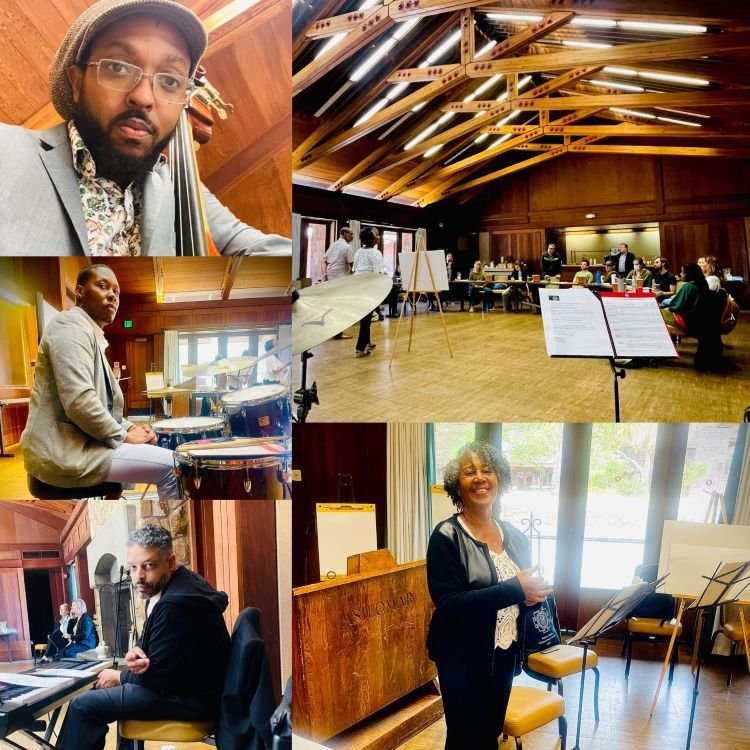The Serious Play of Polarities in Jazz
Photo collage courtesy of Corcoran Holt
Our bassist and musical director, Corcoran Holt, began the deep listening exercise solo, playing a repeated phrase which he modulated modally, drawing all present into the cyclical groove. Drummer McClenty Hunter joined in, establishing a rhythmic counterpoint, aligning yet contrasting via cymbal taps and drum accents. Finally, Zaccai Curtis entered the scene on electric keyboard, floating chords and arpeggios. As Corcoran maintained his mantric tones on “Kharyallah,” a meditative composition written for his mother, McClenty and Zaccai ebbed and flowed in intensity, inspiring Corcoran to vary his phrasing, doubling up notes then going back to the established form.
After achieving a polyphonic high, the JLP Trio transitioned, gently, to quietude, with Zaccai laying out first, then McClenty, ending where we began with Corcoran’s solo bass.
Several participants in the full-day workshop were brought to tears. It was a spiritual moment of transcendent beauty.
This weekend, at the Asilomar Conference Grounds in Pacific Grove, California, Jewel and I facilitated a Jazz Leadership Project workshop for the first cohort of the California Institute of Integral Studies’ Blue Sky Leaders (BSL) program. BSL was established for leaders in a range of fields to develop new capacities and perspectives in “a time of unprecedented technological change, ecological risk, and deepening cultural divisions.” The year-long certificate program integrates “contemplative wisdom, systems understanding, and practical skills to address our most pressing challenges.”
We titled the exercise above “Layered Listening” to orient the participants to the JLP practice of deep, soulful listening: Big Ears, which resonated with the contemplative listening practices they’ve learned and practiced in the earlier portions of the program. Beena Sharma, a long-time leadership and vertical development coach and consultant who emphasizes the resolution of polarities in her work, also engaged in the workshop. After the Layered Listening experience, she shared that when hearing jazz in the past, she perceived it as one undifferentiated sound but now heard it more deeply, not only the different instruments distinctly but how they integrate into a whole.
Parts to whole was one instance of a polarity represented within the jazz tradition that surfaced during the workshop. Others that emerged throughout the day included:
Individual to Group: Derived from jazz music, JLP’s principles begin with the imperative to strive for Individual Excellence and mastery while facing inevitable changes and challenges, Antagonistic Cooperation, a polarity pivot point for growth, learning, and development. The principles that follow are group-oriented, with Shared Leadership as a quality of coordinating and cooperating action grounded in the leadership potential of each member, which lays the foundation for Ensemble Mindset, a collaborative dynamic of healthy high-performance animated by collective intelligence. Examples include masterful jazz groups, sports teams, or scientific collectives in flow states of co-creation.
Serious and Playful: Before outlining our jazz praxis of principles and practices, we provided an overview of our core philosophy, key dynamics, operational characteristics, and leadership outcomes. A fundamental operational methodology in the music and JLP is “serious play.” I explained that the evident mastery of the musicians who captivated their attention in the exercise above was indeed grounded in thousands of hours of serious practice, and travel around the world in bands with other great artists, but that a spirit of play suffused their performances, as in all art.
Freedom within Structure: A keen participant exhibited Big Ears by noticed how in jazz, often one or two instrumentalists lay down a consistent rhythmic groove as a foundation for the improvisational exploration of another. Such a structural device grounds agency so artists make their freestyle aesthetic statements on a secure foundation.
Challenge and Support: A video of Wynton Marsalis and Jon Faddis going head-to-head on Dizzy Gillespie’s “Things to Come” exemplified the Antagonistic Cooperation principle in action. The two trumpet titans challenged one another’s skills and virtuosity but also respectfully supported one another’s drive for excellence in execution. One participant was impressed with Faddis’ powerful high notes; another pointed out that on the surface Faddis’ approach was obviously impressive, but that Wynton showed more range and variety, by, for instance, playing in the lower register of the trumpet as a strategic response to Faddis’ high note proclivity.
The Blues as Such and Blues Music: During lunch, Beena sat to my left, with Jewel to my right, at a table including the JLP Trio and several program participants. I shared Albert Murray’s distinction between what he called “the blues as such,” sadness, anomie, depression, and trauma, and “blues music,” which was created by Black Americans to contend with and counterstate the blues as such while affirming life itself.
Photo of Greg Thomas courtesy of Corcoran Holt
Notice in the examples above, the word “or” was not used. Conventional thinking in modernity too often poses such polarities as Either/Or dynamics rather than Both/And. Jazz integrates polarities and paradoxes by transmuting cultural energy and generative intent into an artistic form that, for those with eyes to see and ears to listen soulfully, holds multiple perspectives simultaneously. Such a post-conventional capacity is a key to bridging our cultural divides.


